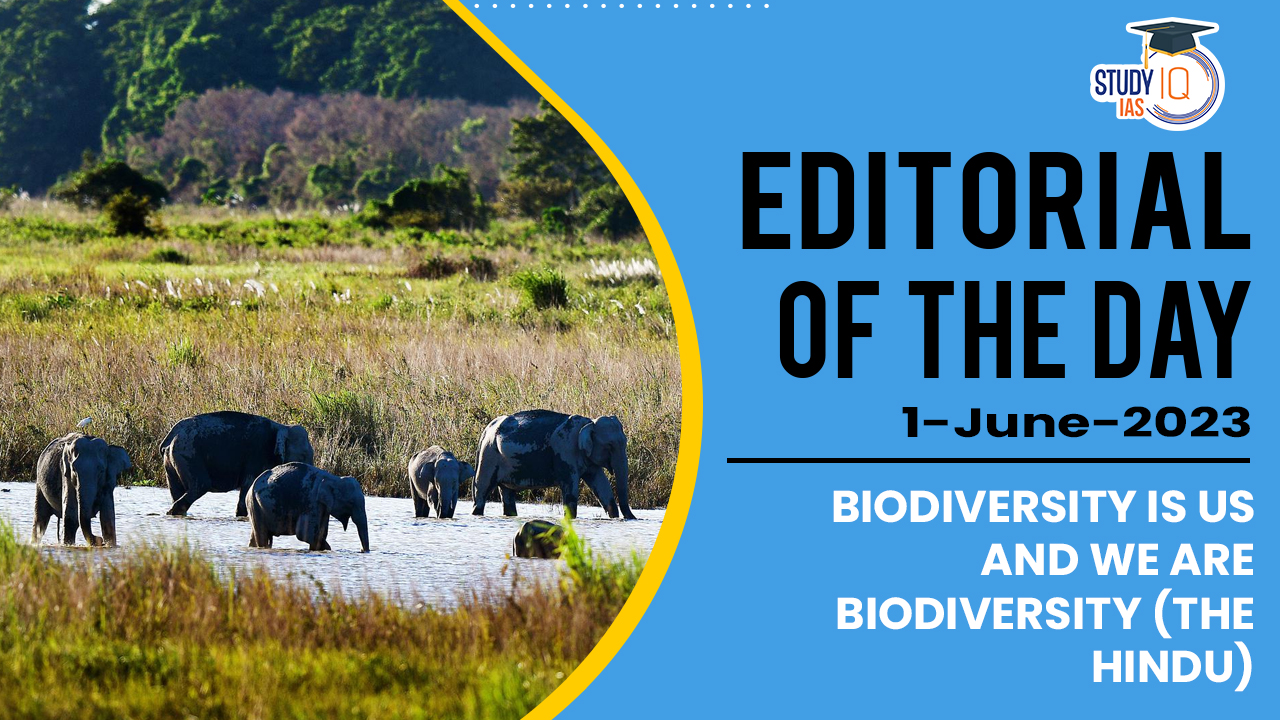Table of Contents
Context: The article is discussing the importance of biodiversity and the need for its protection and enhancement. It emphasises that the engagement of all citizens is crucial in safeguarding the world’s natural heritage. It mentions International Biodiversity Day (May 22) as a reminder of the pivotal role played by the natural world in addressing the climate change crisis and the decline of biodiversity. Moreover, the article explains that biodiversity exists everywhere, from our bodies to our cities and remote wild places and that maintaining and enhancing biodiversity on land and in oceans is a cost-effective way to sequester carbon dioxide from the atmosphere and mitigate climate change. However, the article acknowledges that despite the significance of biodiversity, humanity has not been effective in conserving and managing our natural heritage. In the context of India, while the article mentions the Forest (Conservation) Amendment Bill, will further weaken efforts to sustain biodiversity in the country, it also explains the significance of the National Mission on Biodiversity and Human Wellbeing for biodiversity conservation.
Biodiversity is us and we are biodiversity Background
What is Biodiversity?
- Biodiversity refers to the variety of life forms found on Earth, including the diversity of species, ecosystems, and genetic variations within species.
- It encompasses the full range of plants, animals, microorganisms, and their interactions with each other and their environment.
Significance of Biodiversity
- Ecosystem Stability and Resilience: The interactions between different species help regulate ecological processes, such as nutrient cycling, water purification, and carbon sequestration.
- Ecosystem Services: These services include the provision of food, clean air and water, climate regulation, soil fertility, pollination of crops, natural pest control, and the regulation of diseases.
- Economic Benefits: Industries such as agriculture, fisheries, forestry, and tourism rely on diverse ecosystems and species for their operations. Biodiversity-based industries and nature tourism also generate employment opportunities and contribute to local economies.
- Climate Change Mitigation: Forests, wetlands, and other natural habitats act as carbon sinks, absorbing and storing carbon dioxide from the atmosphere.
- Cultural and Aesthetic Values: Biodiversity is deeply intertwined with human culture and plays a significant role in traditional practices, knowledge systems, and spiritual beliefs.
Threats of Biodiversity

Decoding the Editorial
The article highlights the significance of biodiversity in addressing the climate change crisis and protecting our future.
- Biodiversity & Climate Change:
- The natural world, with its rich variety of life forms and their interconnections, biodiversity plays a crucial role in resolving climate change, which poses a threat to our existence.
- Carbon Sequestration: Biodiversity ecosystems, such as forests, wetlands, and grasslands, act as important carbon sinks. They absorb carbon dioxide (CO2) from the atmosphere through photosynthesis and store it in vegetation, soil, and biomass. The greater the biodiversity within an ecosystem, the more efficient it tends to be in sequestering and storing carbon.
- Alleviating Climate Impacts: Biodiversity-rich ecosystems provide natural buffers against climate change impacts. Coastal ecosystems like mangroves and coral reefs act as natural barriers, protecting shorelines from storm surges and coastal erosion.
- Regulating Climate Feedbacks: Biodiversity ecosystems regulate climate feedback loops, such as the water cycle and the release of greenhouse gases. For instance, intact forests and wetlands help regulate rainfall patterns, reducing the risk of droughts and maintaining water availability.
- Soil Health and Carbon Storage: Soil organisms, such as bacteria, fungi, and earthworms, contribute to nutrient cycling and organic matter decomposition. This process enhances soil fertility and increases its capacity to store carbon.
- Agriculture: Biodiversity also sustains agriculture in the face of climate change by providing genetic diversity for crop adaptation, natural pest and disease control, pollination services, and soil fertility and nutrient cycling.
- Inadequacies in conserving Biodiversity: The article expresses that,
- Globally, as well as in India, we have not done enough to protect and manage our valuable and irreplaceable natural heritage.
- As a result, biodiversity is facing a decline worldwide, and the remaining isolated ecosystems are degrading due to various factors, including the loss of species, climate stressors, and ongoing human pressures.
- In the context of India, the Forest (Conservation) Amendment Bill, is seen as a limitation as it is suggested to further weaken the commitment to preserve the remaining biodiversity.
- Nurturing and managing biodiversity:
- There is a need for a paradigm shift in the management and care of biodiversity.
- Biodiversity is an integral part of human existence, and therefore, civil society must play a crucial role in sustaining it.
- The current approach to managing biodiversity, which primarily relies on the Indian Forest Service, is flawed.
- The term “forest” used to describe India’s natural heritage is inadequate because biodiversity exists not only on land but also in water bodies, rivers, deltas, and oceans.
- India’s ecosystems encompass a diverse range of environments, such as grasslands, savannas, alpine pastures, deserts, and other ecological communities.
- Even in the 20th century, there was recognition of living organisms and the interconnectedness of ecosystems and ecosystem services in landscapes heavily influenced by human activities.
- However, in the 21st century, the terms “forests” and “wildlife” have limited meaning or usefulness in capturing the complexity and interconnectedness of biodiversity.
- Therefore, a broader and more inclusive approach is required to acknowledge and manage the diverse ecosystems and their services.
- There is a need to shift towards a perspective of multifunctional landscapes, where the involvement of local communities is central to the conservation and sustainability of life on Earth.
- The Forest Rights Act enacted in India in 2006 aimed to increase the involvement of indigenous groups in the ownership and management of biodiversity. However, the implementation of the Act has been limited.
- Thus, it is time to move beyond the steps outlined in the Act and fundamentally change the way biodiversity is managed.
- There has to be integration of biodiversity into daily actions, emphasising the need to mainstream biodiversity considerations in development programs, government departments, and public and private institutions.
- Decentralisation in the management of biodiversity, involving multiple stakeholders, particularly local communities, through mechanisms such as gram sabhas (village councils) and biodiversity management committees is also advocated.
Way Forward
- The article discusses the proposed National Mission on Biodiversity and Human Wellbeing, which aims to mainstream biodiversity in India.
-
- The idea was conceptualised by leading conservation biologists working under the Biodiversity Collaborative in Bengaluru, and it has received initial approval from the Prime Minister’s Science, Technology, and Innovation Council.
- The Mission seeks to address critical challenges related to climate change, natural and regenerative agriculture, and ecosystem and public health by utilizing biodiversity and ecosystem services, often referred to as nature-based solutions.
- The ultimate objective is to enhance and conserve biodiversity to promote human well-being and contribute to achieving the United Nations Sustainable Development Goals, particularly in poverty alleviation, nutrition and health, environmental protection, and fostering a new green economy.
- The article concludes by suggesting that embracing such a pledge and actively participating in biodiversity conservation would be a meaningful way to celebrate and protect our invaluable natural world.


 National Security Advisory Board revampe...
National Security Advisory Board revampe...
 Foundation Day of Indian States and UTs,...
Foundation Day of Indian States and UTs,...
 Assam Police Constable Cut Off 2025 Out,...
Assam Police Constable Cut Off 2025 Out,...





















